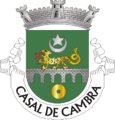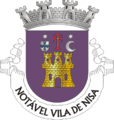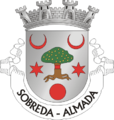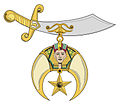Star and crescent
The star and crescent is a symbol which is a conjoined representation of a
Both elements of the symbol have a long history in the
The combination is found comparatively rarely in late
History
Origins and predecessors


Crescents appearing together with a star or stars are a common feature of Sumerian iconography, the crescent usually being associated with the moon god
In Late Bronze Age Canaan, star and crescent moon motifs are also found on Moabite name seals.[13]
| |
| |
| |
The depiction of the crescent-and-star or "star inside crescent" as it would later develop in Bosporan Kingdom is difficult to trace to Mesopotamian art. Exceptionally, a combination of the crescent of Sin with the five-pointed
A very early depiction of the symbol (crescent moon, stars and sun disc) is found on the Nebra sky disc, dating from c. 1800-1600 BC (Nebra, Germany). A gold signet ring from Mycenae dating from the 15th century BC also shows the symbol. The star and crescent (or 'crescent and pellet') symbol appears 19 times on the Berlin Gold Hat, dating from c. 1000 BC.
Classical antiquity
Greeks and Romans
Many ancient Greek (classical and hellenistic) and Roman amulets which depict stars and crescent have been found.[17]
By the late
Some Byzantine coins of the 1st century BC and later show the head of Artemis with bow and quiver, and feature a crescent with what appears to be a six-rayed star on the reverse.
-
Star and crescent on a coin ofArgead star).
-
A star and crescent symbol with the star shown in a sixteen-rayed "sunburst" design (3rd century BC) on the Ai-Khanoum plaque.[24]
-
Coin of Mithradates VI Eupator. The obverse side has the inscription ΒΑΣΙΛΕΩΣ ΜΙΘΡΑΔΑΤΟΥ ΕΥΠΑΤΟΡΟΣ with a stag feeding, with the star and crescent and monogram ofPergamum placed near the stag's head, all in an ivy-wreath.[25]
-
Roman-era coin with Greek inscription (1st century AD) with a bust of Artemis on the obverse and an eight-rayed star within a crescent on the reverse side.
The moon-goddess Selene is commonly depicted with a crescent moon, often accompanied by two stars (the stars represent Phosphorus, the morning star, and Hesperus, the evening star); sometimes, instead of a crescent, a lunar disc is used.[26][27][28][29] Often a crescent moon rests on her brow, or the cusps of a crescent moon protrude, horn-like, from her head, or from behind her head or shoulders.[30]
-
The Moon-goddess Selene or Luna accompanied by the Dioscuri, or Phosphoros (the Morning Star) and Hesperos (the Evening Star). Marble altar, Roman artwork, 2nd century AD. From Italy.
-
The goddess Selene, illustration from Meyers Lexikon, 1888.
In the 2nd century, the star-within-crescent is found on the obverse side of Roman coins minted during the rule of Hadrian, Geta, Caracalla and Septimius Severus, in some cases as part of an arrangement of a crescent and seven stars, one or several of which were placed inside the crescent.[31]
-
Coin of Roman Emperor Hadrian (r. 117–138). The reverse shows an eight-rayed star within a crescent.
-
Roman period limestone pediment from with a crescent and a radiant crown.
Iran (Persia)
The star and crescent symbol appears on some coins of the Parthian vassal kingdom of Elymais in the late 1st century AD. The same symbol is present in coins that are possibly associated with Orodes I of Parthia (1st century BC). In the 2nd century AD, some Parthian coins show a simplified "pellet within crescent" symbol.[32]
-
A star and a crescent appearing (separately) on the obverse side of a coin ofOrodes II of Parthia(r. 57–37 BC).
-
Coin of Vardanes I of Parthia (r. c. AD 40–45)
-
Coin of the Sasanian king Kavad II, minted at Susa in 628
-
Gold coin of Khosrow II (r. 570–628).
-
Coin of Khosrow III
-
Coin of Hormizd IV
-
Silver dirham issued by Ispahbudh Khurshid of Tabaristan
-
Arab-Sassanian coin was issued, which was added with arabic writing by theUmayyads
The star and crescent motif appears on the margin of
Use of the star-and-crescent combination apparently goes back to the earlier appearance of a star and a crescent on Parthian coins, first under King Orodes II (1st century BC). In these coins, the two symbols occur separately, on either side of the king's head, and not yet in their combined star-and-crescent form. Such coins are also found further afield in
Ayatollahi (2003) attempts to connect the modern adoption as an "Islamic symbol" to Sassanid coins remaining in circulation after the Islamic conquest
Western Turkic Khaganate
Coins from the Western Turkic Khaganate had a crescent moon and a star, which held an important place in the worldview of ancient Turks and other peoples of Central Asia.[38]
Medieval and early modern
Christian and classical heraldric usage
The
The star and crescent combination appears in attributed arms from the early 14th century, possibly in a coat of arms of c. 1330, possibly attributed to John Chrysostom,[42] and in the
Crescents (without the star) increase in popularity in early modern heraldry in Europe. Siebmachers Wappenbuch (1605) records 48 coats of arms of German families which include one or several crescents.[44]
A star and crescent symbolizing
St. Stephen's Cathedral in Vienna used to have at the top of its highest tower a golden crescent with a star; it came to be seen as a symbol of Islam and the Ottoman enemy, which is why it was replaced with a cross in 1686.[46]
In the late 16th century, the
The star and crescent combination remains rare prior to its adoption by the Ottoman Empire in the second half of the 18th century.[citation needed]
-
Great Seal of Richard I of England (1198)[47]
-
Equestrian seal of Raymond VI, Count of Toulouse with a star and a crescent (13th century)
-
The crescent flag ascribed to the Hungarians against the Mongol Golden Horde in the Battle of Mohi, 1241.
-
Polish coats of arms, called Leliwa (1334 seal)
-
Coats of arms of theThree Magi, with "Baltasar of Tarsus" being attributed a star and crescent increscent in a blue field, Wernigerode Armorial(c. 1490)
-
Coat of arms of John Freigraf of "Lesser Egypt" (i.e. Romani/gypsy),[49] 18th-century drawing of a 1498 coat of arms in Pforzheim church.
-
Depictions of stars with crescents are a common motif on the stećak 12th to 16th century tombstones of medieval Bosnia
-
1668 representation byKorenić-Neorić Armorial
-
The coat of arms of "Illyria" from theKorenić-Neorić Armorial(1590s)
-
Banner of Cumania, used at the coronation of Ferdinand II of Hungary in 1618 and assigned to Gáspár (Caspar) Illésházy.
-
Star and crescent on the obverse of the Jelacic-Gulden of the Kingdom of Croatia (1848)
-
Coat of arms of the noble family Slatte (1625 – 1699) in Sweden.
-
Coat of arms of the noble family Finckenberg (1627 – 1809) in Sweden.
-
Coat of arms of the noble family Boose (1642 – 1727) in Sweden.
-
Banner of theZaporizhian Sich (Cossacksof Ukraine) before 1775.
Muslim usage
While the crescent on its own is depicted as an emblem used on Islamic war flags from the medieval period, at least from the 13th century although it does not seem to have been in frequent use until the 14th or 15th century,[50][51] the star and crescent in an Islamic context is more rare in the medieval period, but may occasionally be found in depictions of flags from the 14th century onward.
Some Mughal era (17th century) round shields were decorated with a crescent or star and crescent.
-
Depiction of a star and crescent flag on theBattle of Yarmouk (manuscript illustration of the History of the Tatars, Catalan workshop, early 14th century).
-
A miniature painting from aMughal Emperor Shah Jahanas bearing a shield with a star and crescent decoration.
-
A painting from a Padshahnama manuscript (1633) depicts the scene of Aurangzeb facing the maddened war elephant Sudhakar. Sowar's shield is decorated with a star and crescent.
-
Ottoman sipahis in battle, holding the crescent banner (by Józef Brandt)
-
Flag of theKingdom of Saudi Arabia) from 1835 to 1921
-
Coat of arms of Khedivate of Egypt (1867–1914)
-
Flag of the Kingdom of Egypt (1922–1953) and co-official flag of the Republic of Egypt (1953–1958)
-
Flag of the Free Officers Movement (1949–1953) and co-official flag of the Republic of Egypt (1953–1958)
-
Flag of theSultanate of Aceh(1496–1903)
Use in the Ottoman Empire
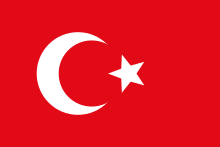

The adoption of star and crescent as the Ottoman state symbol started during the reign of Mustafa III (1757–1774) and its use became well-established during the periods of Abdul Hamid I (1774–1789) and Selim III (1789–1807).[52] A decree (buyruldu) from 1793 states that the ships in the
With the
In addition to Ottoman imperial insignia, symbols appear on the flag of Bosnia Eyalet (1580–1867) and Bosnia Vilayet (1867–1908), as well as the flag of 1831 Bosnian revolt, while the symbols appeared on some representations of medieval Bosnian coat of arms too.
In the late 19th century, "Star and Crescent" came to be used as a metaphor for Ottoman rule in British literature.
After the foundation of the
Contemporary use
National flags
The flag of
Other states in the Ottoman sphere of influence using the star and crescent design in their flats such as Libya (1951, re-introduced 2011) and Algeria (1958). The modern emblem of Turkey shows the star outside the arc of the crescent, as it were a "realistic" depiction of a conjunction of Moon and Venus, while in the 19th century, the Ottoman star and crescent was occasionally still drawn as the star-within-crescent. By contrast, the designs of both the flags of Algeria and Tunisia (as well as Mauritania and Pakistan) place the star within the crescent.
The same symbol was used in other
(1959),-
Flag of theRif Republic
-
Flag of Sahrawi Arab Democratic Republic
-
Flag of Umm al-Quwain
-
Flag of East Turkestan(1934)
-
Flag of Syrian Turkmen
-
Flag of Azad Kashmir
-
Alash Autonomy (1917)
-
Turkestan Autonomy (1917-1918)
National flags with a crescent alongside several stars:
-
Flag of Singapore (1965): crescent and five stars
-
Flag of Uzbekistan (1991): crescent and twelve stars
-
Flag of Turkmenistan (2001): crescent and five stars (representing five provinces)
-
Flag of the Comoros (2002): crescent and four stars (representing four islands)
-
southern cross
National flags and coat of arms with star, crescent and other symbols:
-
Flag of Moldova (1990)
-
Flag of Croatia (1990)
-
Flag ofMiꞌkmaꞌki(1867)
-
Flag of Moldavia (15th to 16th century)
Symbol of Islam

By the mid-20th century, the symbol came to be re-interpreted as a symbol of Islam or the Muslim community.[56] This symbolism was embraced by movements of Arab nationalism or Islamism in the 1970s too, such as the proposed Arab Islamic Republic (1974) and the American Nation of Islam (1973).[57]
Cyril Glassé in his The New Encyclopedia of Islam (2001 edition, s.v. "Moon") states that "in the language of conventional symbols, the crescent and star have become the symbols of Islam as much as the cross is the symbol of Christianity."[1]
By contrast, Crescent magazine — a religious Islamic publication — quoted without giving names that "Many Muslim scholars reject using the crescent moon as a symbol of Islam".[9]
On February 28, 2017, it was announced by the Qira County government in Hotan Prefecture, Xinjiang, China that those who reported others for stitching the 'star and crescent moon' insignia on their clothing or personal items or having the words 'East Turkestan' on their mobile phone case, purse or other jewelry, would be eligible for cash payments.[58]
Municipal coats of arms
The star and crescent as a traditional heraldic charge is in continued use in numerous municipal coats of arms (notably the based on the Leliwa (Tarnowski) coat of arms in the case of Polish municipalities).
-
Coat of arms ofHalle an der Saale, Germany (1327).
-
Coat of arms of Mińsk Mazowiecki, Poland.
-
Coat of arms of Przeworsk, Poland.
-
Coat of arms of Tarnobrzeg, Poland.
-
Coat of arms of Tarnów, Poland.
-
Coat of arms of Zagreb, Croatia.
-
Flag ofestoile (with eight wavy rays).[59]
-
Coat of arms of Mattighofen, Austria (1781)
-
Coat of arms of Oelde, Germany (1910).
-
Coat of arms of Niederglatt, Switzerland (1928)[60]
-
Coat of arms of Niederweningen, Switzerland (1928)[60]
-
Coat of arms of Drogheda, Ireland
-
Coat of arms ofAlgueirão-Mem Martinsparish, Portugal
-
Coat of arms of Aljezur parish, Portugal
-
Coat of arms of Casal de Cambra parish, Portugal
-
Coat of arms of Celorico da Beira municipality, Portugal
-
Coat of arms of Nisa municipality, Portugal
-
Coat of arms of Nossa Senhora das Misericórdias parish, Portugal
-
Coat of arms of Oliveira do Bairro municipality, Portugal
-
Coat of arms of Penacova municipality, Portugal
-
Coat of arms of São Brás de Alportel parish, Portugal
-
Coat of arms of Sintra municipality, Portugal
-
Coat of arms of Sobreda parish, Portugal
-
Coat of arms of Vouzela municipality, Portugal
Sports Club Emblems
In rugby union, Saracens F.C. incorporates the crescent and star in its crest. Drogheda United F.C., Portsmouth F.C., and S.U. Sintrense all borrow the crescent and star from their respective towns' coats of arms. Mohammedan SC in Kolkata, India also incorporates the symbol in its crest.
-
Emblem of Saracens F.C.
Other uses
-
Post WWII flag of the Japan Air Self-Defense Force (JASDF)
-
Flag of the Pakistan Army
-
Flag of the Alpha Delta Phi fraternity
-
Insignia of East Bengal Regiment
-
Logo ofShriners International
-
Logo of the Felicity Party
-
Logo of the Crescent Star Party of Indonesia
See also
- Star
- Lunar phase
- Pentagram of Venus
- New Orleans Police Department
References
- ^ a b c Cyril Glassé , The New Encyclopedia of Islam (revised ed. 2001), s.v. "Moon" (p. 314).
- ^ Andrew G. Traver, From Polis to Empire, The Ancient World, c. 800 B.C.–A.D. 500, Greenwood Publishing Group, 2002, p. 257
- ^ "The star and crescent are common Persian symbols, being a regular feature of the borders of Sassanian dirhems." Philip Grierson, Byzantine Coins, Taylor & Francis, 1982, p118
- ^ Bradley Schaefer (21 December 1991). "Heavenly Signs". New Scientist: 48–51.
- ^ David Lance Goines (18 October 1995). "Inferential evidence for the pre-telescopic sighting of the crescent Venus".
- ^ This would explain cases where the inside curve of the crescent has a smaller radius of curvature than the outer, the opposite of what happens with the moon. Jay M. Pasachoff (1 February 1992). "Crescent Sun". New Scientist.
- ^
"There are also three cases [... viz., associated with the "Danubian RiderReligion"] where the star, figured as a radiate disc 'balancing the crescent moon', must represent Sol, balancing Luna who is represented as a crescent instead of in bust. The 'star in crescent' theme itself appears only once, on an engraved gem, accompanied by the lion and an indecipherable inscription [...] This theme is connected with the Orient and has a long history behind it in the Hittite, Babylonian, Assyrian, Sassanid and Iranian worlds. Campbell gives us valuable particulars. The heavenly bodies thus symbolized were seen as the powerful influence of cosmic fatalism guiding the destinies of men." Dumitru Tudor, Christopher Holme (trans.), Corpus Monumentorum Religionis Equitum Danuvinorum (CMRED) (1976), p. 192 (referencing Leroy A. Campbell, Mithraic Iconography and Ideology' '(1969), 93f.
- ^ e.g. Catalogue of the Greek coins in The British Museum (2005), p. 311 (index).
- ^ a b "Many Muslim scholars reject using the crescent moon as a symbol of Islam. The faith of Islam historically had no symbol, and many refuse to accept it." Fiaz Fazli, Crescent magazine, Srinagar, September 2009, p. 42.
- ^ A similar stele found in Babylon is kept in the British Museum (no. 90837).
- ^ Michael R. Molnar, The Star of Bethlehem, Rutgers University Press, 1999, p78
- Ishtar (Inannato the Sumerians)" Irving L. Finkel, Markham J. Geller, Sumerian Gods and Their Representations, Styx, 1997, p71. André Parrot, Sumer: The Dawn of Art, Golden Press, 1961
- ^ Othmar Keel, Christoph Uehlinger, Gods, Goddesses, and Images of God in Ancient Israel, Fortress Press, 1998, p. 322.
- Egyptian Grammar: Being an Introduction to the Study of Hieroglyphs. 3rd Ed., pub. Griffith Institute, Oxford, 1957 (1st edition 1927), p. 486.
- ^ W. J. Hinke, A New Boundary Stone of Nebuchadrezzar I from Nippur with a Concordance of Proper Names and a Glossary of the Kudurru Inscriptions thus far Published (1907), 120f.
University of Pennsylvania Museum of Archaeology and Anthropology, object nr. 29-20-1.
- ^ J. V. Canby, Reconstructing the Ur Nammu Stela, Expedition 29.1, 54–64.
- ISBN 978-0-8122-4935-4.
- ^ B.C. McGing, The Foreign Policy of Mithradates VI Eupator, King of Pontus, Brill, 1986, p 97
- ^ "The star and the crescent, the emblem of the Pontus and its kings, were introduced by Mithradates and his successors to the Bosporus and appeared on Bosporan coins and locally produced jewelry. On the coins this symbol often appears near the head of a young man wearing a Phrygian cap, who is identified as either a solar deity or his deified worshipper. [...] the star and the crescent, the badge of the Pontus and its kings, shown on the Colchian amphora stamp, and appearing on engraved finger-rings discovered in this area allude to the possibility of an earlier association of the Pontic dynasty with the cult of mounted Mithra. Mithra in fact must have been one of the most venerated gods of the Pontic Kingdom, since its rulers bore the theophoric name of Mithradates [...] although direct evidence for this cult is rather meager." Yulia Ustinova, The Supreme Gods of the Bosporan Kingdom, Brill, 1998, 270–274
- ^
Strabo (12.3.31) writes that Mēn Pharnakou had a sanctuary at Kabeira in Pontus where the Pontic kings would swear oaths. Mēn Pharnakou is a syncretistic Anatolian-Iranian moon deity not directly comparable to Zoroastrian Māh. Albert F. de Jong, Traditions of the Magi: Zoroastrianism in Greek and Latin Literature (1997), %A9n%20Pharmakou&f=false p. 306.
- ^ "His royal emblem, an eight rayed star and the crescent moon, represented the dynasty's patron gods, Zeus Stratios, or Ahuramazda, and Mén Pharnakou, a Persian form of the native moon goddess." Andrew G. Traver, From Polis to Empire—The Ancient World c. 800 B.C.–A.D. 450, Greenwood Publishing Group, 2002, p. 257
- ^ "The significance of the star and crescent on royal coins has also been frequently debated. Many scholars have identified the star and the crescent as royal symbols of the Pontic kingdom. Their appearance on every royal issue suggests they were indeed important symbols, and the connection of this symbol to the royal family is definite. The nature of it, however, is still uncertain. Kleiner believed they were symbols of an indigenous god and had their origins in Persia. He associated the star and crescent with the god Men and saw them as representations of night and day (the star may be considered the sun here). Ritter, on the other hand, suggested that the star and crescent symbols derived from Perseus, just as the star symbol of the Macedonians did. […] Ma and Mithras are two other deities with whom the star and crescent symbol are associated. Olshausen believed that the star and crescent could be related to a syncretism of Pontic and Iranian iconography: the crescent for Men and the star for Ahura Mazda. Recently, Summerer has convincingly suggested that Men alone was the inspiration for the symbol on the royal coins of the Pontic kingdom. Deniz Burcu Erciyas, "Wealth, Aristocracy, and Royal Propaganda Under The Hellenistic Kingdom of The Mithradatids in The Central Black Sea Region in Turkey", Colloquia Pontica Vol.12, Brill, 2005, p 131
- ^ "Devotion to Hecate was especially favored by the Byzantines for her aid in having protected them from the incursions of Philip of Macedon. Her symbols were the crescent and star, and the walls of her city were her provenance." Vasiliki Limberis, Divine Heiress, Routledge, 1994, p 15.
"In 340 B.C., however, the Byzantines, with the aid of the Athenians, withstood a siege successfully, an occurrence the more remarkable as they were attacked by the greatest general of the age, Philip of Macedon. In the course of this beleaguerment, it is related, on a certain wet and moonless night the enemy attempted a surprise, but were foiled by reason of a bright light which, appearing suddenly in the heavens, startled all the dogs in the town and thus roused the garrison to a sense of their danger. To commemorate this timely phenomenon, which was attributed to Hecate, they erected a public statue to that goddess [...]" William Gordon Holmes, The Age of Justinian and Theodora, 2003 p 5-6; "If any goddess had a connection with the walls in Constantinople, it was Hecate. Hecate had a cult in Byzantium from the time of its founding. Like Byzas in one legend, she had her origins in Thrace. Since Hecate was the guardian of "liminal places", in Byzantium small temples in her honor were placed close to the gates of the city. Hecate's importance to Byzantium was above all as deity of protection. When Philip of Macedon was about to attack the city, according to the legend she alerted the townspeople with her ever-present torches, and with her pack of dogs, which served as her constant companions. Her mythic qualities thenceforth forever entered the fabric of Byzantine history. A statue known as the 'Lampadephoros' was erected on the hill above the Bosphorous to commemorate Hecate's defensive aid." Vasiliki Limberis, Divine Heiress, Routledge, 1994, p 126-127.
This story survived in the works , who in all probability lived in the time of Photius and the 10th century lexicographer Suidas. The tale is also related by Stephanus of Byzantium, and Eustathius.
- .
- ^ H. G. Liddell, A History of Rome from the earliest times to the establishment of the Empire (1857), p. 605. C.f. forumancientcoins.com.
- ^ LIMC, Selene, Luna 35.
- ISBN 9780892369423, pp. 178–179;
- ^ Savignoni L. 1899. "On Representations of Helios and of Selene." The Journal of Hellenic Studies 19: pp. 270–271
- ISBN 9781428655447. p.23
- ^ British Museum 1923,0401.199; LIMC Selene, Luna 21 Archived 21 November 2018 at the Wayback Machine; LIMC Selene, Luna 4 Archived 21 November 2018 at the Wayback Machine; LIMC Mithras 113 Archived 21 November 2018 at the Wayback Machine; LIMC Selene, Luna 15 Archived 21 November 2018 at the Wayback Machine; LIMC Selene, Luna 34 Archived 21 November 2018 at the Wayback Machine; LIMC Selene, Luna 2 Archived 21 November 2018 at the Wayback Machine; LIMC Selene, Luna 7 Archived 21 November 2018 at the Wayback Machine; LIMC Selene, Luna 9 Archived 21 November 2018 at the Wayback Machine; LIMC Selene, Luna 10 Archived 21 November 2018 at the Wayback Machine; LIMC Selene, Luna 19 Archived 21 November 2018 at the Wayback Machine. For the close association between the crescent moon and horns see Cashford.
- ^ Selene and Luna on Roman Coins (forumancientcoins.com):
"Bronze coin of Caracalla from Nicopolis ad Istrum with a single star in the arms of the crescent moon; coin of Geta showing five stars; a denarius of Septimius Severus with an array of seven stars."
Roman-era coins from Carrhae (Harran): Carrhae, Mesopotamia, modern day Harran (wildwinds.com)
- ^ Michael Alram, Nomina Propria Iranica in Nummis, Materialgrundlagen zu den iranischen Personennamen auf Antiken Münzen (1986); C. Augé, "Quelques monnaies d'Elymaïde," Bulletin de la Société Française de Numismatique, November 1976; N. Renaud, "Un nouveau souverain d'Elymaïde," Bulletin de la Société Française de Numismatique, January 1999, pp. 1-5. Coins of Elymais (parthia.com).
- ^ "The star and crescent are common Persian symbols, being a regular feature of the borders of Sassanian dirhems." Philip Grierson, Byzantine Coins, Taylor & Francis, 1982, p118
- ^ "A rare type with crescent and star alone on the reverse is probably Chashtana's earliest issue, struck before he extended his power into Malwa." H.H. Dodwell (Ed.), The Cambridge Shorter History of India, Cambridge University Press, 1935, p. 83.
- ^ Achaemenid period:
"not normally associated with scenes cut in the Court Style"; Persepolis seal PFS 71 (M. B. Garrison in Curtis and Simpson (eds.), The World of Achaemenid Persia: History, Art and Society in Iran and the Ancient Near East (2010), p. 354)
PFS 9 (M. B. Garrison, Seals And The Elite At Persepolis; Some Observations On Early Achaemenid Persian Art (1991), p. 8).
Parthian period: "[t]he Parthian king Mithradates I conquered Mesopotamia around 147 BC, and Susa in about 140 BC A later Parthian king, Orodes II (58-38 BC), issued coins at Susa and elsewhere which display a star and crescent on the obverse. The succeeding ruler, Phraates IV (38-3/2 BC), minted coins showing either a star alone or a star with crescent moon. In representing the star and crescent on their coins the Parthians thus adopted traditional symbols used in Mesopotamia and Elammore than two millennia before their own arrival in those parts." John Hansman, "The great gods of Elymais" in Acta Iranica, Encyclopédie Permanente Des Etudes Iraniennes, v.X, Papers in Honor of Professor Mary Boyce, Brill Archive, 1985, pp 229–232
- ^ "Sasani coins remained in circulation in Moslem countries up to the end of the first century (Hijra). This detailed description of Sasani crowns was presented because the motifs mentioned, particularly the crescent and star gradually changed into Islamic symbols and have often appeared in the decorative patterns of various periods of Islamic art. [...] The flags of many Islamic countries bear crescents and stars and are proof of this Sasani innovation." Habibollah Ayatollahi (trans. Shermin Haghshenās), The Book of Iran: The History of Iranian Art, Alhoda UK, 2003, pp 155–157
- ^ "when we come to examine the history of the crescent as a badge of Muhammadanism, we are confronted by the fact that it was not employed by the Arabs or any of the first peoples who embraced the faith of the prophet" "The truth is that the crescent was not identified with Islam until after the appearance of the Osmanli Turks, whilst on the other hand there is the clearest evidence that in the time of the Crusades, and long before, the crescent and star were a regular badge of Byzantium and the Byzantine Emperors, some of whom placed it on their coins." William Ridgeway, "The Origin of the Turkish Crescent", in The Journal of the Royal Anthropological Institute of Great Britain and Ireland, Vol. 38 (Jul. - Dec. 1908), pp. 241-258 (p 241)
- JSTOR 43283250.
- ^ In the 12th century found on pennies of William the Lion (r. 1174–1195). William Till, An Essay on the Roman Denarius and English Silver Penny (1838), p. 73. E.g. "Rev: short cross with crescent and pellets in angles and +RAVLD[ ] legend for the moneyer Raul Derling at Berwick or Roxburgh mint" (timelineauctions.com). Seaby SE5025 "Rev. [+RAV]L ON ROC, short cross with crescents & pellets in quarters" (wildwinds.com Archived 16 November 2019 at the Wayback Machine).
- ^ Bohemond III of Antioch (r. 1163–1201) "Obv. Helmeted head of king in chain-maille armor, crescent and star to sides" (ancientresource.com)
- ^ "Billon denier, struck c. late 1140s-1164. + RA[M]VNDVS COMS, cross pattée, pellet in 1st and 2nd quarters / CIVI[TAS T]RIPOLIS, eight-rayed star with pellets above crescent. ref: CCS 6-8; Metcalf 509 (ancientresource.com).
- Roy P. Mottahedeh, The Crusades From the Perspective of Byzantium and the Muslim World, Dumbarton Oaks, 2001, p 278
- ^ p. 21; adopted by Virgil Solis in his Wappenbüchlein (1555)
- ^ Sara L. Uckelman, An Ordinary of Siebmacher's Wappenbuch (ellipsis.cx) (2014)
- ISBN 978-953-8013-03-4. Retrieved 16 April 2022.
- ^ "Wien 1, Stephansdom, Mondschein". Österreichische Akademie der Wissenschaften (in German). Retrieved 2 March 2024.
- ^ Richard is depicted as seated between a crescent and a "Sun full radiant" in his second Great Seal of 1198. English heraldic tradition of the early modern period associates the star and crescent design with Richard, with his victory over Isaac Komnenos of Cyprus in 1192, and with the arms of Portsmouth (Francis Wise A Letter to Dr Mead Concerning Some Antiquities in Berkshire, 1738, p. 18). Heraldic tradition also attributes a star-and-crescent badge to Richard (Charles Fox-Davies, A Complete Guide to Heraldry, 1909, p. 468).
- ^ Found in the 19th century at the site of the Biais commandery, in Saint-Père-en-Retz, Loire-Atlantique, France, now in the Musée Dobré in Nantes, inv. no. 303. Philippe Josserand, "Les Templiers en Bretagne au Moyen Âge : mythes et réalités", Annales de Bretagne et des Pays de l'Ouest 119.4 (2012), 7–33 (p.24).
- ^ In 15th-century Europe, it was widely assumed that the gypsies were Egyptians (hence the name gypsies), and several gypsy leaders are known to have styled themselves as "counts of lesser Egypt". Wilhelm Ferdinand Bischoff, Deutsch-Zigeunerisches Wörterbuch (1827), p.14
- ^ Mohd Elfie Nieshaem Juferi, "What Is The Significance Of The Crescent Moon In Islam?". bismikaallahuma.org. 12 October 2005. Retrieved 21 September 2017.
- ^ Pamela Berger, The Crescent on the Temple: The Dome of the Rock as Image of the Ancient Jewish Sanctuary (2012), p. 164f
- ^ a b İslâm Ansiklopedisi (in Turkish). Vol. 4. Istanbul: Türkiye Diyanet Vakfı. 1991. p. 298.
- ^ "It seems possible, though not certain, that after the conquest Mehmed took over the crescent and star as an emblem of sovereignty from the Byzantines. The half-moon alone on a blood red flag, allegedly conferred on the Janissaries by Emir Orhan, was much older, as is demonstrated by numerous references to it dating from before 1453. But since these flags lack the star, which along with the half-moon is to be found on Sassanid and Byzantine municipal coins, it may be regarded as an innovation of Mehmed. It seems certain that in the interior of Asia tribes of Turkish nomads had been using the half-moon alone as an emblem for some time past, but it is equally certain that crescent and star together are attested only for a much later period. There is good reason to believe that old Turkish and Byzantine traditions were combined in the emblem of Ottoman and, much later, present-day Republican Turkish sovereignty." Franz Babinger (William C. Hickman Ed., Ralph Manheim Trans.), Mehmed the Conqueror and His Time, Princeton University Press, 1992, p 108
- ^ e.g. A. Locher, "With Star and Crescent: A Full and Authentic Account of a Recent Journey with a Caravan from Bombay to Constantinope"; Andrew Haggard, "Under Crescent and Star" (1895).
- ^ "Mosque and minaret are surmounted by crescents; the air glowing over the Golden Horn is, as it were, full of moons." Hezekiah Butterworth, Zigzag journeys in the Orient vol. 3 (1882), p. 481.
- Hijra(migration) of our Prophet Mohammed from his home in order to spread Islam and teach the principles of right and virtue. The Star represents our smiling hope, the beauty of aim and object and the light of our belief in God, in our country, its dignity and honour which illuminate our way and puts an end to darkness."
- ^ Edward E. Curtis, Black Muslim religion in the Nation of Islam, 1960–1975 (2006), p. 157.
- ^ Joshua Lipes; Jilil Kashgary (4 April 2017). "Xinjiang Police Search Uyghur Homes For 'Illegal Items'". Radio Free Asia. Translated by Mamatjan Juma. Retrieved 16 December 2019.
A second announcement, issued Feb. 28 by the Chira (Cele) county government, said those who report individuals for having "stitched the 'star and crescent moon' insignia on their clothing or personal items" or the words "East Turkestan"—referring to the name of a short-lived Uyghur republic—on their mobile phone case, purse or other jewelry, were also eligible for cash payments.
- ^ The blazon of the coat of arms is attested in the 19th century, as Azure a crescent or, surmounted by an estoile of eight points of the last (William Berry, Robert Glover, Encyclopædia Heraldica, 1828). This is apparently based on minor seals used by Portsmouth mayors in the 18th century (Robert East H. Lewis, Extracts from Records in the Possession of the Municipal Corporation of the Borough of Portsmouth and from Other Documents Relating Thereto, 1891, p. 656). The medieval seal showed no such design (Henry Press Wright, The Story of the 'Domus Dei' of Portsmouth: Commonly Called the Royal Garrison Church, 1873, p. 12). The claim connecting the star and crescent design to the Great Seal of Richard I originates in the mid 20th century (Valentine Dyall, Unsolved Mysteries: A Collection of Weird Problems from the Past, 1954, p. 14).
- ^ a b c Peter Ziegler (ed.), Die Gemeindewappen des Kantons Zürich (1977), 74–77.
- Charles Boutell, "Device of Star (or Sun) and Crescent". In The Gentleman's Magazine, Volume XXXVI (New Series). London: John Nicols & Son, London, 1851, pp. 514–515
External links
 Media related to Star and crescent at Wikimedia Commons
Media related to Star and crescent at Wikimedia Commons The dictionary definition of ☪ at Wiktionary
The dictionary definition of ☪ at Wiktionary


![A star and crescent symbol with the star shown in a sixteen-rayed "sunburst" design (3rd century BC) on the Ai-Khanoum plaque.[24]](http://upload.wikimedia.org/wikipedia/commons/thumb/9/9c/AiKhanoumPlateSharp.jpg/182px-AiKhanoumPlateSharp.jpg)
![Coin of Mithradates VI Eupator. The obverse side has the inscription ΒΑΣΙΛΕΩΣ ΜΙΘΡΑΔΑΤΟΥ ΕΥΠΑΤΟΡΟΣ with a stag feeding, with the star and crescent and monogram of Pergamum placed near the stag's head, all in an ivy-wreath.[25]](http://upload.wikimedia.org/wikipedia/commons/thumb/1/11/CoinOfMithVI.jpg/325px-CoinOfMithVI.jpg)


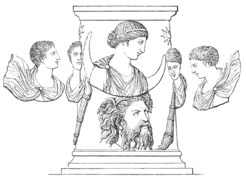


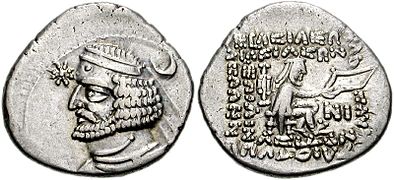



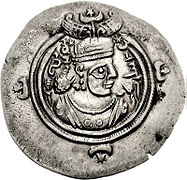


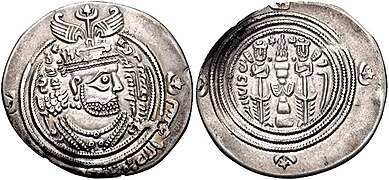
![Great Seal of Richard I of England (1198)[47]](http://upload.wikimedia.org/wikipedia/commons/thumb/4/46/Seal_of_Richard_I_of_England.jpg/120px-Seal_of_Richard_I_of_England.jpg)



![Templar seal of the 13th century, probably of the preceptor of the commanderies at Coudrie and Biais (Brittany).[48]](http://upload.wikimedia.org/wikipedia/commons/thumb/2/2c/Frater_Robert_seal_templar.png/120px-Frater_Robert_seal_templar.png)


![Coat of arms of John Freigraf of "Lesser Egypt" (i.e. Romani/gypsy),[49] 18th-century drawing of a 1498 coat of arms in Pforzheim church.](http://upload.wikimedia.org/wikipedia/commons/thumb/5/5b/Wappenbild_freigrafen_1448.jpg/96px-Wappenbild_freigrafen_1448.jpg)

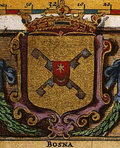


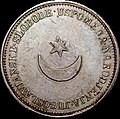





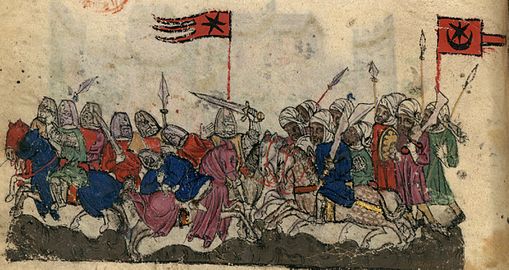
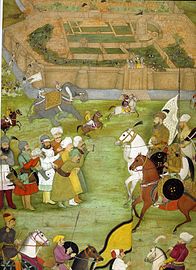








































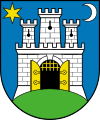
![Flag of Portsmouth, England (18th century): crescent and estoile (with eight wavy rays).[59]](http://upload.wikimedia.org/wikipedia/commons/thumb/5/56/City_Flag_of_Portsmouth.svg/120px-City_Flag_of_Portsmouth.svg.png)

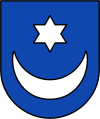
![Coat of arms of Niederglatt, Switzerland (1928)[60]](http://upload.wikimedia.org/wikipedia/commons/thumb/a/a6/Niederglatt-blazon.svg/103px-Niederglatt-blazon.svg.png)
![Coat of arms of Oberglatt, Switzerland (1928)[60]](http://upload.wikimedia.org/wikipedia/commons/thumb/0/04/Oberglatt-blazon.svg/102px-Oberglatt-blazon.svg.png)
![Coat of arms of Niederweningen, Switzerland (1928)[60]](http://upload.wikimedia.org/wikipedia/commons/thumb/6/65/Niederweningen-blazon.svg/103px-Niederweningen-blazon.svg.png)



